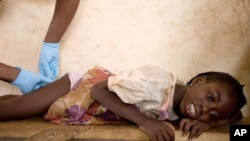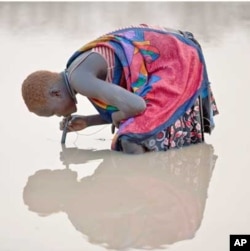Guinea worm is on course to become the second human disease to be eradicated, after smallpox, thanks largely to intervention overseen by former U.S. President Jimmy Carter. Little was known about the infection for decades, as diseases like malaria took priority. However, previously unpublished research from the 1970s, released this month, shows the burden the disease has had on millions of people.
Watch: Jimmy Carter Leads Push to Eradicate Guinea Worrm
Guinea worm is contracted when people drink water contaminated with tiny crustaceans that contain the worm larvae. A year later, a meter-long female worm emerges through a painful blister, often disabling the infected person for months.
Professor Brian Greenwood, a British scientist, first came across Guinea worm in the 1970s when working in northern Nigeria. He says little was known about the disease, despite millions suffering from it across Africa and India.
"People were much more concerned with malaria, bilharzia and other tropical infections," Greenwood said. "And part of the reason was that these people were so disabled they never got to the clinic or the hospital. So that if you looked in hospital records, you did not see this as a big problem."
Greenwood spent four years studying the disease and trying to find out why sufferers often developed repeat infections, without developing immunity.
"We extracted some of the worms," he said. "And the traditional way is winding them out on a matchstick, just gradually. And the problem is that if the worm then snapped inside, then they got a very severe reaction."
Greenwood credits the Carter Center, a charitable foundation set up by former U.S. President Jimmy Carter, for helping fight the disease to the brink of eradication.
There is no vaccine or treatment. Instead, community education programs teach people to filter drinking water and avoid entering water sources.
Speaking in 2011, Carter described the initial difficulties.
"It was kind of an insult to say 'this disease comes out of your pond,'" he said. "So we have had to do a lot of diplomacy and convincing the people there to take care of their own problems. Well, it has worked. And now almost every nation on earth has eradicated or eliminated Guinea worm."
When the Carter Center first became involved in 1986, there were around 3.5 million cases in 21 countries; last year, 25 cases were recorded in only three countries — Chad, Ethiopia and South Sudan.
Greenwood's early study of Guinea worm remained unpublished, as he was directed to focus on malaria and meningitis instead; but last year in London, he met Carter, who persuaded him to publish the research.
"I hope that we have been able to document what a horrible disease this was," Greenwood said. "And it is really important that people realize that. And if we do get eradication in the next year or two, which I hope will be the case, that this will not just be seen as a minor thing, but to be a really very important public health triumph."
The last few cases of Guinea worm remain because they are the most difficult to reach. Many are in conflict areas like South Sudan, but scientists are optimistic this ancient disease can be eradicated within the next few years.











